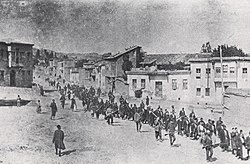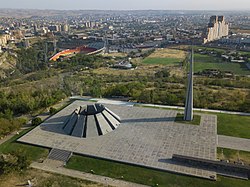The Armenian genocide was a period in the history of the Ottoman Empire during the First World War when the state there attempted to engage in genocide against the large minority of Armenian Christians living in Türkiye and the Caucasus region. The genocide came about owing to the growing Turkish, Islamic nationalism of the Ottoman state in the nineteenth and early twentieth centuries. It was carried out by taking thousands of Armenians at a time on forced death marches toward the Syrian Desert between 1915 and 1918. In total, the genocide resulted in the deaths of somewhere between 600,000 and 1,500,000 Armenians, though the figures are a matter of dispute owing to imprecise historical records. Although there is universal academic consensus that these events occurred and the actions of the Ottoman state constituted genocide, Türkiye so far has refused to acknowledge this and a majority of nation-states have never publicly acknowledged that the Armenian genocide occurred. It subsequently resulted in the migration of hundreds of thousands of Armenians away from Turkey and the Caucasus regions, with most heading either for the United States or the Soviet Union.[1]
Chronology of eventsChronology of events
Throughout its history, the Ottoman Empire had a long history of religious and racial tolerance in general; when it expanded to cover much of the Eastern Mediterranean, Balkans and the Middle East in the fifteenth and sixteenth centuries, the sultans and their administrators created a situation in which Greek Orthodox Christians and other racial and religious minorities such as the Armenians and the Jews were tolerated even if they refused to convert to Islam. However, this tolerance slowly began to break down in the nineteenth century, as the Ottoman Empire began to collapse and a more sectarian brand of Turkish Muslim nationalism developed.[2]
The Armenian people, who lived in great numbers in Eastern Anatolia and in the Armenia Highlands, soon became the victims of this growing intolerance amongst the Turks. For instance, isolated acts of violence occurred in several locations across the empire in the 1890s, while in 1909 somewhere between 20,000 and 30,000 Armenians were massacred in the southern Turkish city of Adana as local officials and Islamic leaders reacted to an unsuccessful countercoup in Turkey at large against the Young Turks who had claimed power in the empire the previous year. As with the pogroms faced by the Jewish population of the Russian Empire at this time, these attacks were often perpetuated owing to wider political and social problems within the state, with the Armenians being used as scapegoats.[3]

The Armenian genocide took place within the context of the First World War, which erupted across Europe in the summer of 1914.[4] With the Turks at war with countries like Britain, France and Russia, the pretense of any adherence to international laws was abandoned by the Ottomans and the Ottoman army and state initiated a program designed to remove the Armenian population, which numbered over two million, from the Ottoman Empire entirely or at least from Turkey itself from 1915 onwards. The methods developed to do this were forced marches of thousands of Armenians across Turkey toward the Syrian Desert, all overseen by the Ottoman military. However, these were effectively death marches, with massacres occurring along the way and limited food and water provided to the victims so that many died of thirst or starvation.[5]
This program continued throughout the war. It did not, however, result in the full-scale genocide of the empire’s Armenian population. But those who remained had little interest in remaining under Turkish rule after the war ended and, in any event, a major civil war broke out across Turkey in the aftermath of the conflict, one which would last longer than the First World War itself and which saw many powers such as Britain, Greece, and Italy intervening. It was in this context that many Armenians began preparing to leave Turkey.[6]
Extent of migrationExtent of migration
Armenian migration from the Ottoman Empire had already begun in the late nineteenth century as the Turkish state stepped up its persecutory politics. By the early 1910s, thousands were leaving each year, many heading for the United States to settle in New England and other regions, though others were heading north to the Russian Empire and some stayed in what today are Syria and Lebanon, where there were Christian minorities established since the advent of Christianity, as well as French protection. This rate increased in the years following the genocide, as many people determined to abandon their ancient lands for safer pastures. The outflow was perhaps not as great as some other events of this kind. For instance, while the pogroms committed against the Jews of the Russian Empire in the nineteenth and early twentieth centuries led to the flight of upwards of two million Jews from those lands, only somewhat over half a million Armenians left Turkey and the Caucasus. This was owing to the creation of the First Armenian Republic in 1918 in the aftermath of the First World War as a state for the Armenian people, a republic that was created out of lands taken from the Ottoman Empire and the Russian Empire at the end of the war and became a haven for many Armenians from the Ottoman Empire.[7]
Demographic impactDemographic impact

The demographic impact of the migration of the Armenian people has been most clearly felt in the United States and Russia. There is a debate today as to exactly how many people are of Armenian descent within the USA, with some studies placing the figure as low as half a million, but others suggesting a figure between one million and one and a half million. The Armenian American community has produced many well-known figures, notably the eight-time grand slam tennis champion André Agassi, while the Kardashian sisters are descended from an Armenian family which left the Ottoman Empire shortly before the genocide began, and have become the most vocal celebrities advocating for recognition of the Armenian Genocide.[8] Modern censuses estimate that there are roughly 1.2 million people of Armenian descent living in Russia today. Many of these are descended from people who migrated to the region in the early twentieth century as a result of state persecution within the Ottoman Empire, however, it is more difficult to assess this accurately as the proximity of the Armenian state to south-western Russia has led to a large degree of migration throughout the twentieth and early twenty-first centuries.[9]
See alsoSee also
Explore moreExplore more
- The newspaper collections on MyHeritage include information about historical events, births, deaths, marriages, businesses, naturalizations, court cases, and more.
- Search MyHeritage Family Trees
- Search last nameson MyHeritage
References
- ↑ THE ARMENIAN GENOCIDE (1915-16): OVERVIEW. United States Holocaust Musuem
- ↑ Baer, Marc; Makdisi, Ussama; Shryock, Andrew. Tolerance and Conversion in the Ottoman Empire: A Conversation. Comparative Studies in Society and History, Vol. 51, No. 4 (Oct., 2009), pp. 927-940
- ↑ Adana Massacre (1909). Armenian National Institute
- ↑ The Entry of the Ottoman Empire into World War I. Türk Tarih Kurumu
- ↑ Armenian Genocide (1915-1923). Armenian National Institute
- ↑ Turkey profile - Timeline. BBC News
- ↑ Der Sarkissian, Anouche . David Gutman, The Politics of Armenian Migration to North America, 1885-1915: Sojourners, Smugglers, and Dubious Citizens. Edinburgh University Press, 2019, 246 p.
- ↑ What Kim Kardashian Has Said About the Armenian Genocide. Newsweek
- ↑ Armenians in Russia and the USSR. Encyclopedia.com

